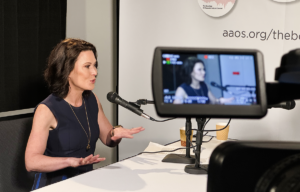Why Every Step You Take on Stage Matters More Than You Think
As a leader, your presence on stage begins the moment you take your first step. While content and delivery are crucial, the way you move — particularly how you walk — sends powerful signals about your confidence, authority, and executive presence.
Developing a strong stage presence isn’t just about what you say; it’s about how you carry yourself from the moment you enter the spotlight.
Below are essential movement techniques we teach our clients to command attention and respect every time they take the stage.
Eliminate the Shuffle: Step with Purpose
One of the most common mistakes we see among speakers is shuffling across the stage. This seemingly minor habit creates multiple problems that undermine your authority.
Here’s why purposeful walking matters and how to master it.
- Audio Impact: Shuffling creates distracting noise through the microphone system. When your feet drag or catch, the audience hears every scrape and stumble, drawing attention away from your message.
- Visual Authority: Shuffling signals uncertainty and nervousness, even when you feel confident inside. Your movement and non-verbal communication should reflect the strength of your ideas and your position as a leader.
- Energy Projection: Deliberate steps create a sense of intention and control. When you lift your feet and place them with purpose, you project confidence that resonates throughout the room.
Master the Art of the Heel-First Landing
For women wearing heels or anyone wearing any dress shoe, proper foot placement is crucial for both sound control and confident appearance.
When walking on stage, the heel-down technique is essential. Begin each step by placing your heel down first, followed by the rest of your foot. This creates a smooth, controlled movement and results in a quieter step — crucial when you’re near sensitive audio equipment or microphones that can easily pick up unwanted noise.
It’s equally important to avoid stepping toe-first. Leading with your toes can make your gait appear unsteady and may cause you to catch your front foot, resulting in awkward movements or distracting noises. These small missteps can pull focus away from your message and diminish your executive presence.
Finally, be sure to practice walking in the shoes you’ll wear during your presentation. Different shoes require slight adjustments in balance and stride. Rehearsing in your actual footwear will help you maintain grace and control when it matters most.
Walk Like You Own the Space
Your movement on stage should reflect your authority and ownership of the moment.
Command the Stage with Confident Movement.
- Claim Your Territory: Move with intention across the stage. Don’t confine yourself to a small area unless the space requires it. Use the full stage to emphasize points and connect with different sections of your audience.
- Pause with Purpose: When you stop walking, plant your feet firmly. Avoid swaying or shifting weight, which can undermine the strength of your position.
- Build Executive Presence Through Movement: Every step should reinforce your message. Walk toward the audience when making important points, step back when transitioning between topics.
Practice Your Stage Entrance: Step by Step
First impressions matter, and your entrance sets the tone for your entire presentation.
- Know Your Cue: Understand exactly when you’ll walk on — whether it’s after an introduction, a video, or music. Anticipate your moment.
- Visualize the Space: Familiarize yourself with the stage layout. Know where entrances, exits, podiums, and lighting hot spots are.
- Rehearse Your Walk: Practice walking from your entrance point to your speaking position. Keep your pace steady and purposeful.
- Plant with Confidence: Once you reach center stage, stop cleanly. Stand tall with both feet grounded to signal control and readiness.
- Breathe and Begin: Take a calm breath before speaking. This brief pause centers you and sets a composed tone for your opening.
Why the Unique Challenges Women Face Matter
Women speakers often face additional scrutiny regarding their physical presence and movement. Professional coaching can help you navigate these challenges while maintaining authenticity.
When walking on stage, it’s important to balance confidence with approachability. Your stride should project strength and purpose. Aim for a presence that commands respect while still feeling open and relatable to your audience.
If you’re concerned about height — whether you’re taller or shorter than average — remember that presence isn’t about physical stature. Purposeful, confident movement can help you project authority and assurance, no matter your height.
Finally, don’t overlook wardrobe considerations. Practice your stage walk in the exact outfit you plan to wear, whether that’s a pencil skirt, suit, or flowing dress. Make sure your clothing supports your movement and doesn’t restrict your ability to walk with confidence and ease.
Step Into Your Power: Transform Your Stage Presence Through Purposeful Movement
Your walk is more than transportation from point A to point B: it’s a powerful tool for establishing authority, maintaining audience engagement, and reinforcing your message. By eliminating shuffling, mastering proper foot placement, and moving with intention, you’ll command attention from the moment you step onto any stage.
Remember, as a leader, every aspect of your presence matters. When you walk with purpose and confidence, you set the stage for audiences to receive your message with the respect and attention it deserves.
Are you ready to step into your power and transform your stage presence?
We’re here to help you master every aspect of executive presence at JPG!





